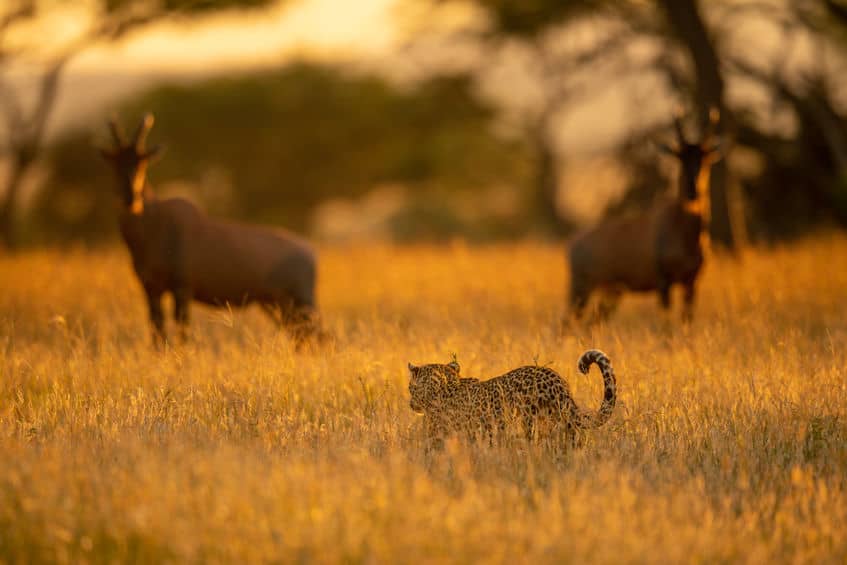
Leopards are among the best of the best when it comes to hunting. They are elusive and can easily sneak around without getting noticed. Since they are such great hunters, I thought it would be interesting to write a post about how they actually hunt.
Leopards rely on a combination of stealth and strength. They utilize their camouflage and excellent night vision to sneak up behind their unsuspecting target and striking when they are within a short distance.
Leopards carry around an incredible arsenal of super-sensitive senses and when you combine that with raw strength and agility, you get the ultimate hunter. In this post, I have dived into some of the things that make leopards one of Africa’s most incredible hunters.
Leopards Rely on Stealth and Strength
Leopards are equipped with several senses and physical advantages that give them an incredible ability to sneak around without anybody noticing them or having any idea that a leopard is nearby.
Like other cats, leopards have whiskers but in addition to the whiskers on their head, leopards also have whiskers on their angles. These whiskers are connected to a high number of nerves and are extremely sensitive and allow the leopards to know instantly when something touches them or when they touch anything that might make a sound such as vegetation, dirt, or rocks.
On top of this, leopards have some very sensitive hairs in their fur all over their body.
This combination gives leopards complete awareness of their entire body at all times which allows them to sneak around completely silently and unnoticed by unsuspecting prey without stepping on branches, breaking vegetation, or anything that might startle their target.
On top of having the ability to glide through the vegetation like a shadow and go completely unnoticed, leopards are remarkably strong predators.
Leopards are solitary creatures which means that they do not have the advantage of outnumbering their prey when it comes to hunting but they easily make up for this with their strength. Despite being the smallest of the big cats, they are incredibly strong and are pound-for-pound the strongest cats in Africa.
It is not uncommon for leopards to take down prey much larger and heavier than themselves and then carry it to safety several meters up in a tree using its strong jaw and neck
The Element of Surprise
Leopards are not as fast as some of the other big cats. They sprint at 60 km/h where the cheetah for instance can sprint almost twice as fast at 110 km/h and lion at approximately 80 km/h.
Instead, leopards rely on the element of surprise by utilizing their incredible camouflage, stealth, and maneuverability to sneak up behind their target. They will usually get as close as within 5 meters before they attack.
Once within a very short distance of their target prey, leopards will strike without giving their target prey any head-start or chance of escaping.

Leopards Carry Their Prey Up Into a Tree to Secure it
Once a leopard has caught and overpowered its prey, it is time to secure it and enjoy the fresh meal.
Leopards have larger front paws than back paws and the reason for this is, that the large front paws in combination with the strong, bulky legs must be able to support the weight of the large and strong neck and skull.
All of this combined with some incredibly powerful jaws allow leopards to carry their prey up into trees where it will hang the prey over a thick branch before eating it.
Leopards are without a doubt among some of the best climbers in the world and it is not uncommon to see leopards carry prey much larger and heavier than themselves up to as much as 15 meters (50 feet) into a tree. Something other large predators such as lions, cheetahs, hyenas, or African wild dogs are nowhere near capable of. This is just one of many abilities that makes leopards unique.
There are several reasons why leopards often carry their prey up into trees instead of just eating it on the ground.
Having the ability to carry heavy prey up into trees allows leopards to have their meal and stay in peace from other large predators such as lions, cheetahs, hyenas, or African wild dogs.
It is, however, not uncommon that leopards accidentally drop some of their freshly caught prey on the ground below their tree. When this happens, scavengers such as hyenas, who have not been blessed with leopards’ incredible ability to climb, can be both quick and ruthless in claiming the dropped food.
Other than securing and eating prey, leopards are also often seen resting in trees as these provide security from the predators I mentioned before but also a nice, cold spot in the shadow cast by the treetops.
Leopards can also use their climbing skills to escape larger predators such as lions, hyenas, or African wild dogs that may be chasing them.
Leopards Hunt at Night
Leopards are nocturnal animals that are active and hunt mostly at night. You can of course be lucky and spot them during the day in sunlight so keep an eye out for them but don’t count too much on it.
Instead, go out while it is dark. I highly recommend going on game drives in the early morning before sunrise or in the late evening before sunset. Just remember that in many national parks in Africa, the gates to the rest camps open and close at specific hours, so do not be late.
One of the most incredible leopard sightings I have personally ever had, happened on a game drive in the very early morning, long before sunrise just a few hundred meters away from our rest camp in Kruger Nation Park of South Africa where a leopard was within just a few meters of our car, just walking along the road.
Leopards’ vision in low-light conditions is approximately 7 times stronger than humans’. They use their terrific night vision to gain yet another advantage when moving around and gliding effortlessly and silently through the grass and other vegetation when sneaking up on unsuspecting prey.

A Broad Menu
Other cats such as lions and cheetahs thrive the most when they have certain prey animals around. Lions usually go after larger prey such as zebras, buffalos, and large antelopes. Cheetahs thrive the most in areas where they can hunt many medium-sized antelopes such as impalas and springboks.
Where other big African cats require somewhat specific prey animals to thrive, leopards have a much broader menu of more than 100 different animals. They can live off almost everything ranging from tiny critters and frogs, scorpions, birds, and fish to larger animals such as gazelles.
Leopards preferred sources of food seem to consist of medium-sized antelopes such as impalas, springboks, and waterbucks but what they eat depends largely on the region they are in and what prey animals are available to them.
What leopards’ primary food consists of also affects how large they get to a great extend. Leopards with access to larger prey will usually be able to eat more with less effort put into it since catching an impala (for instance) will go a lot further and most likely be much easier than catching enough small critters to provide a comparable amount of food.
The largest leopard ever on record weighed an incredible 91 kg. and although this is much above the average weight of a leopard, they are still definitely considered to be big cats with a typical weight between 25-30 kg. with the males at the higher end of that scale and the females on the lower end.
